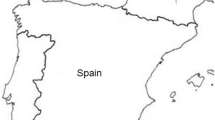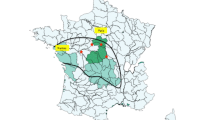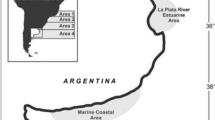Abstract
Polychlorinated biphenyls (∑PCB), DDT isomers (∑DDT), chlordanes (∑CHLOR), toxaphene, chlorobenzenes and hexachlorocyclohexane isomers and seven elements (As, Cd, Cu, Hg, Pb, Se, Zn) were determined in tissues of 41 stranded pilot whales (Globicephala melaena) and 27 ice-entrapped white-beaked dolphins (Lagenorhynchus albirostris) from Newfoundland, Canada. Cadmium, Hg, As and Se were significantly higher in pilot whale kidney and liver than in dolphin tissues. Mercury in liver and blubber, and Cd in kidney, of pilot whales were positively correlated with age. Cadmium levels in both species were much higher than reported for other cetaceans from Canadian east coast waters. Lead concentrations in dolphin kidney and mucles were 5 times higher than in pilot whales. Levels of ∑PCB (sum of 49 congeners) in blubber samples ranged from 31 to 61 mg/kg (lipid wt) in female and male dolphins, respectively, and from 5.6 to 12 mg/kg in female and male pilot whales. ∑DDT and toxaphene were present at similar levels to ∑PCB while mean ∑CHLOR (sum of seven components) ranged from 1.6 to 17 mg/kg in blubber of pilot whales and dolphins, respectively. The presence of high levels of toxaphene in the blubber of both species was unexpected and may be due to increased use of this pesticide during the 1970's. Higher levels of all organochlorine chemicals in blubber, as well as Pb in kidney and muscle, of dolphins than in pilot whales may reflect greater exposure to contaminants because of overwintering and feeding in Gulf of St. Lawrence waters.
Similar content being viewed by others
References
Addison RF, Brodie PF, Zinck ME, Sergeant DE (1984) DDT has declined more than PCBs in eastern Canadian seals during the 1970s. Environ Sci Technol18:935–937
Addison RF, Zinck ME, Ackman RG (1972) Residues of organochlorine pesticides and polychlorinated biphenyls in some commercially produced Canadian marine oils. J Fish Res Board Can29:349–355
Aguilar A (1984) Relationship of DDE/∑DDT in marine mammals to the chronology of DDT input into the ecosytem. Can J Fish Aquat Sci41:840–844
Andersen SH, Rebsdorff A (1976) Polychlorinated hydrocarbons and heavy metals in harbour porpoise (Phocoena pho-coena) and whitebeaked dolphin (Labgenorhynchus albirostris) from Danish waters. Aquat Mamm4:14–20
Arima S, Nagakura K (1979) Mercury and selenium content of odontoceti. Bull Jpn Soc Sci Fish45:623–626
Armstrong FAJ and Uthe JF (1971) Semi-automated determination of mercury in animal tissues. Atom Absorpt Newsletter10:101–103
Ballschmiter K, Zell M (1980) Baseline studies of the global pollution I. Occurrence of organohalogens in pristine European and Antarctic aquatic environments. Intern J Environ Anal Chem8:15–35
Bildeman TF, Christensen EJ, Billings WN, Leonard R (1981) Atmospheric transport of organochlorines in the North Atlantic gyre. J Mar Res39:443–464
Bingley JB, Dufty JH (1972) Distribution of copper in the tissues of the bovine neonate and dam. Res Vet Sci13:8–14
Bruckmann G, Zondek SG (1939) CCXXIX Iron, copper, and maganese in human organs at various ages. Biochem J33:1845–1857
Duinker JC, Hillebrand MThJ (1983) Composition of PCB mixtures in biotic and abiotic marine compartments (Dutch Wadden Sea). Bull Environ Contam Toxicol31:25–32
Duinker JC, Hillebrand MThJ, Nolting, RF (1979) Organochlorines and metals in harbour seals (Dutch Wadden Sea). Mar Pollut Bull10:360–364
Freeman HC, Uthe JF, Silk PJ (1983) Polychlorinated biphenyls, organochlorine pesticides, and chlorobenzenes content of livers from Atlantic cod (Gadus morhua) caught off Halifax, Nova Scotia. Environ Monit Assess4:389–394
Gaskin DE, Holdrinet M, Frank R (1971) Organochlorine pesticide residues in harbour porpoises from the Bay of Fundy region. Nature223:499–500
Gaskin DE, Smith DJD, Arnold PW, Louisy MV, Frank R, Holdrinet M, McWade JW (1974) Mercury, DDT, dieldrin, and PCB in two species of Odontoceti (Cetacea) from St Lucia, Lesser Antilles. J Fish Res Board Can31:1235–1239
Gaskin DE, Stonefield KI, Suda P, Frank R (1979) Changes in mercury levels in harbour porpoises from the Bay of Fundy, Canada and adjacent waters during 1969–1977. Arch Environ Contam Toxicol8:733–762
Gaskin DE (1982) The Ecology of Whales and Dolphins. Heinemann, London, UK
Gaskin DE, Frank R, Holdrinet M (1983) Polychlorinated biphenyls in harbour porpoises,Phocoena phocoena (L), from the Bay of Fundy, Canada and adjacent waters, with some information on chlordane and hexachlorobenzene levels. Arch Environ Contam Toxicol12:211–219
Hansen LG, Tuinstra LGMTh, Kan CA, Strik JJTWA, Koeman JJ (1983) Accumulation of chlorobiphenyls in chicken fat and liver after feeding Aroclor® 1254 directly or fat from swine fed Aroclor® 1254. J Agric Food Chem31:254–260
Harms U, Drescher HE, Huschenbeth E (1978) Further data on heavy metals and organochlorines in marine mammals from German coastal waters. Meeresforschung26:153–161
Helle E, Olsson M, Jensen S (1976) DDT and PCB levels and reproduction in ringed seal from the Bothnian Bay. Ambio5:188–189
Honda K, Tatsukawa R, Fujiyama T (1982) Distribution characteristics of heavy metals in the organs and tissues of striped dolphin,Stenella coeruleoalba. Agric Biol Chem46:3011–3021
Honda K, Tatsukawa R, Itano K, Miyazaki N, Fujiyama T (1983) Heavy metal concentrations in muscle, liver, and kidney tissues of striped dolphin,Stenella coeruleoalba, and their variations with body length, weight, age and sex. Agric Biol Chem47:1219–1228
Jansson B, Vaz R, Blomkvist G, Jensen S, Olsson M (1979) Chlorinated terpenes and chlordane components found in fish, guillemot, and seal from Swedish waters. Chemosphere4:181–190
Koeman JH, Peters WHM, Koudstaal-Hol CHM, Tjioe PS, De Goeij JJM (1973) Mercury-selenuim correlations in marine mammals. Nature (Lond)245:385–386
Koeman JH, Van de Ven WSM, De Goeij JJM, Tjioe PS, Haaften JL (1975) Mercury and selenium in marine mammals and birds. Sci Total Environ3:279–287
Kramer W, Buchert H, Reuter U, Biscoito M, Maul DG, Le Grand G, Ballschmiter K (1984) Global baseline pollution studies IX. C6-C14 organochlorine compounds in surfacewater and deep-sea fish from the eastern North Atlantic. Chemosphere13:1255–1267
Lien J, Dong J, Baratt L, Hanney J, Chu K (1982) Whale entrapments in inshore fishery gear during 1982. Report to Canada Dept of Fisheries and Oceans, Newfoundland Region, 36 pp
Lien J, Fawcett L, Staniforth S (1984) Whales and Seals of Newfoundland and Labrador. Breakwater Books, St John's Newfoundland, 136 pp
Martineau D, Beland P, Desjardins C, Lagace A (1987) Levels of organochlorine chemicals in tissues of beluga whales (Delphinapterus leucas) from the St Lawrence estuary, Quebec, Canada. Arch Environ Contam Toxicol16:137–147
Masse R, Martineau D, Tremblay L, Beland P (1986) Concentrations and Chromatographie profile of DDT metabolites and PCB residues in stranded beluga whales (Delphinapterus leucas) from the St Lawrence estuary—Canada. Arch Environ Contam Toxicol15:567–579
McLeod DJ (1981) Recent mass strandings of the long-finned pilot whale (Globicephala melaena, Traill) in Newfoundland. CAFSAC WP/07/81
Mills RA, Millis CD, Dannan GA, Guengerich, FP, Aust, SD (1985) Studies on the structure-activity relationships for the metabolism of polybrominated biphenyls by rat liver microsomes. Toxicol Appl Pharmacol78:98–104
Miyazaki T, Yamagishi T, Matsumoto M (1985) Isolation and structure elucidation of some components in technical grade chlordane. Arch Environ Contam Toxicol14:475–483
Muir DCG, Norstrom RJ, Simon S (1988) Organochlorine contaminants in arctic marine food chains: Accumulation of specific PCB congeners and chlordane-related compounds. Environ Sci Technol, In Press.
Mullin M (1985) Presented at the Workshop on High Resolution PCB Analysis, US Environ Protection Agency, Large Lakes Research Station, Grosse, Ile, MI
Musial CJ, Uthe JF (1983) Widespread occurrence of the pesticide toxaphene in Canadian east coast marine fish. Inter J Environ Anal Chem14:117–126
Norstrom RJ, Won H (1985) Long-term preservation of egg and tissue homogenates for determination of organochlorine compounds: Freezing versus freeze-drying. J Assoc Offic Anal Chem68:129–135
Norstrom RJ (1987) Patterns and trends of PCB contamination in Canadian wildlife. In: Proceedings of Conference on PCBs and Replacement Fluids, Institute for Electronic and Electrical Engineers, Montreal 1986, In press
Norstrom RJ, Simon M, Muir DCG, Schweinsburg, RE (1988) Organochlorine contaminants in arctic marine food chains: Identification, geographical distribution and temporal trends in polar bears. Environ Sci Technol, In press.
O'Shea TJ, Brownell RL Jr, Clark DR Jr, Walker WA, Gay ML, Lamont TG (1980) Organochlorine pollutants in small cetaceans from the Pacific and South Atlantic Oceans, November 1968–June 1976. Pestic Monit J14:35–46
Reijnders PJH (1980) Organochlorine and heavy metals residues in harbour seals from the Wadden Sea and their possible effects on reproduction. Neth J Sea Res14:30–65
Ronald K, Frank RJ, Dugan JL, Frank R, Braun HE (1984) Pollutants in harp seals (Phoca groenlandica). I. Organochlorines. Sci Total Environ38:133–152
Saschenbrecker PW (1973) Levels of DDT and PCB compounds in North Atlantic fin-back whales. Can J Comp Med37:203–206
Scott DP, Uthe JF, Chou CL (1981) Further considerations of time trend determinations for contaminant levels in Canadian cod. Int'l Coun Explor Sea C M 1981/E:47 Marine Environ Qual Comm. 15 pp
Sergeant DE, Fisher HD (1957) The smaller cetaceans of eastern Canadian waters. J Fish Res Board Can14:83–115
Sergeant DE (1962) The biology of the pilot or pothead whale,Globicephala melaena Traill, in Newfoundland waters. Fish Res Board Can Bull132, 84 pp
Shain W, Overmann SR, Wilson LR, Kostas J, Bush B (1986) A congener analysis of polychlorinated biphenyls accumulating in rat pups after perinatal exposure. Arch Environ Contam Toxicol15:687–707
Steel RDG, Torrie JH (1980) Principles and Procedures of Statistics McGraw-Hill, NY 633 pp
Stoneburner DL (1978) Heavy metals in tissues of stranded short-finned pilot whales. Sci Total Environ9:293–297
Sullivan JR, Armstrong DE (1985) Toxaphene status in the Great Lakes. University of Wisconsin Sea Grant Institute, Priority Pollutants Status Report No 2 University of Wisconsin, Madison WI, 39 pp
Systat (1985) The System for Statistics, Systat Inc, Evanston, IL
Tanabe S, Nakagawa Y, Tatsukawa R (1981) Absorption efficiency and biological half-life of individual chlorobiphenyls in rats treated with Kanechior® products. Agric Biol Chem45:717–726
Tanabe S, Tatsukawa R, Kawano M, Hidaka H (1982) Global distribution and atmospheric transport of chlorinated hydrocarbons: HCH (BHC) isomers and DDT compounds in the western Pacific, eastern Indian Ocean and Antarctic oceans. J Oceanogr Soc Japan38:137–148
Tanabe S, Tanaka H, Tatsukawa R (1984) Polychlorobiphenyls, ∑DDT, and hexachlorocyclohexane isomers in the western North Pacific ecosystem. Arch Environ Contam Toxicol13:731–738
Tanabe S, Watanabe S, Kan H, Tatsukawa R (1986) Capacity and mode of PCB metabolism in small cetaceans. Mar Mammal Sci, In press
Taruski AG, Olney CE, Winn HE (1975) Chlorinated hydrocarbons in cetaceans. J Fish Res Board Can32:2205–2209
Ten Noever de Brauw MC, Ingen CV, Koeman JH (1973) Mirex in seals. Sci Total Environ2:196–198
US Environmental Protection Agency (1976) Pesticidal aspects of chlordane and heptachlor in relation to man and the environment A further review, 1972–1976. PBN-258 339, Natioal Technical Information Service, Washington, DC, 85 pp
Viale D (3978) Evidence of metal pollution in cetacea of the western Mediterranean. Ann Inst Oceanogr, Paris54:5–16
Vijan PN, Wood GR (1976) An automated submicrogram determination of selenium in vegetation by quartz-tube furnace atomic-absorption spectrophotometry. Talanta23:89–94
Wagemann R, Snow NB, Lutz A, Scott DP (1983) Heavy metals in tissues and organs of the narwhal (Monodon monoceros). Can J Fish Aquat Sci40:206–214
Wagemann R, Muir DCG (1984) Concentrations of heavy metals and organochlorines in marine mammals of northern waters: Overview and evaluation. Can Tech Rep Fish Aquat Sci1279, 100 pp
Watson L (1981) Sea Guide to Whales of the World. Hutchinson, London, UK
Wideqvist U, Jansson B, Reutergardh L, Sundstrom G (1984) The evaluation of an analytical method for polychlorinated terpenes (PCC) in biological samples using an internal standard. Chemosphere13:367–379
Zell M, Ballschmiter K (1980) Baseline studies of the global pollution II Global occurrence of hexachlorobenzene (HCB) and polychlorocamphenes (Toxaphene) (PCC) in biological samples. Z Anal Chem300:387–402
Zitko V, Choi PMK, Wildish DJ, Monaghan CF, Lister NA (1974) Distribution of PCB andp,p′-DDE residues in Atlantic herring (Clupea harengus harengus) and yellow perch (Perca flavescens) in Eastern Canada—1972, Pesticides Monit18:105–109s
Author information
Authors and Affiliations
Rights and permissions
About this article
Cite this article
Muir, D.C.G., Wagemann, R., Grift, N.P. et al. Organochlorine chemical and heavy metal contaminants in white-beaked dolphins (Lagenorhynchus albirostris) and pilot whales (Globicephala melaena) from the coast of Newfoundland, Canada. Arch. Environ. Contam. Toxicol. 17, 613–629 (1988). https://doi.org/10.1007/BF01055830
Received:
Revised:
Issue Date:
DOI: https://doi.org/10.1007/BF01055830




